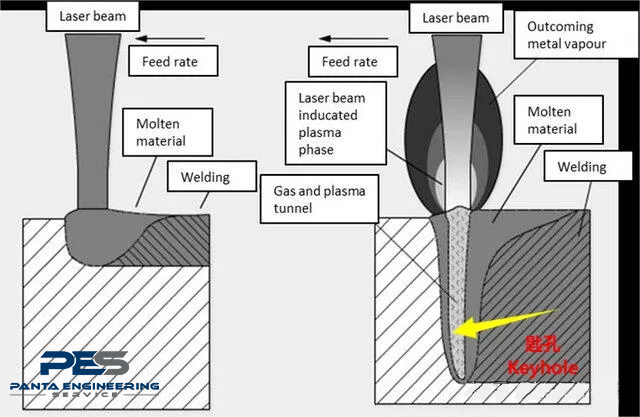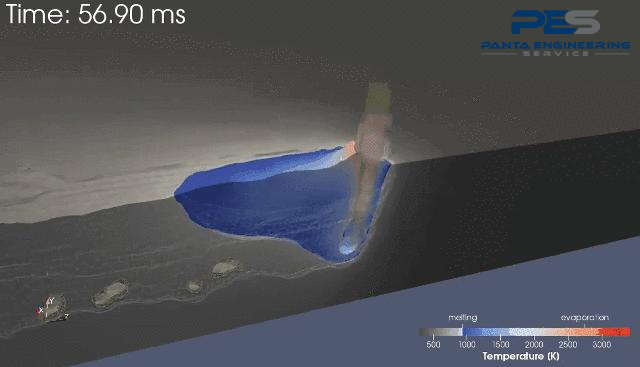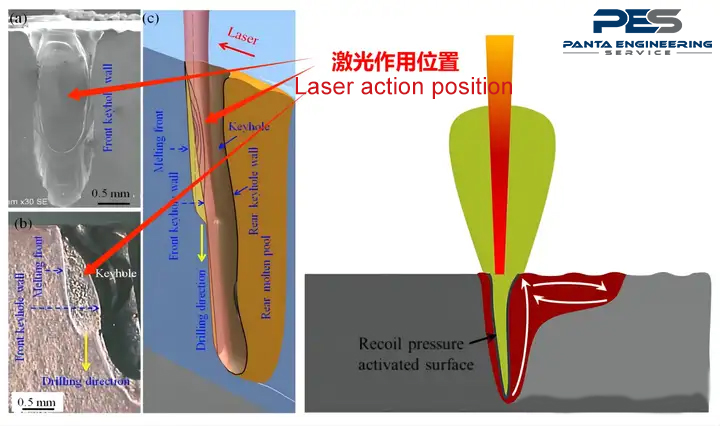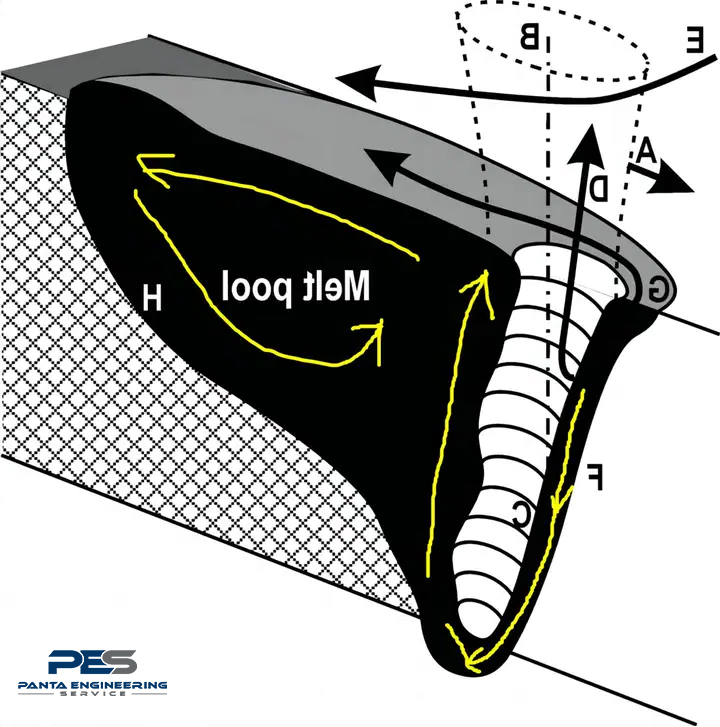Laser welding spatter formation mechanism 1
Jul 10, 2024Laser welding machine welding principle:
The process principle of laser welding is to use the high energy density laser beam generated by the laser, through a focusing mirror or other optical system, to focus the beam on the surface or inside of the material to be welded, forming a small heat source area, so that the material quickly melts or vaporizes, thereby forming a molten pool or keyhole. Laser welding can be divided into molten pool mode and keyhole mode. The former is suitable for thin plates or low power welding, and the latter is suitable for thick plates or high power welding.
Laser welding is divided into thermal conduction and deep fusion welding.
There is almost no spatter in thermal conduction welding: thermal conduction welding is mainly achieved by heat transfer from the surface of the material to the inside, and there is almost no spatter in the process. The process does not involve violent evaporation of metal and violent physical metallurgical reactions.
Deep fusion welding is the main scene for spatter: Deep fusion welding involves laser directly reaching the inside of the material, transferring heat to the inside of the material through the keyhole, and the process reaction is violent, which is the main scene for spatter.
Definition of spatter:
The spatter in welding refers to the molten metal droplets ejected from the molten pool during the welding process. These droplets may fall on the surrounding working surface, resulting in a rough and uneven surface, and may also cause a loss of molten pool quality, forming pits and explosion points on the weld surface, affecting the mechanical properties of the weld.
Spatter classification:
Small spatter: solidified droplets existing at the edge of the weld and on the surface of the material, mainly affecting the appearance, and having no effect on the performance; generally, the droplets are less than 20% of the weld molten width as the boundary for distinction;
Large spatter: there is a mass loss, manifested as pits, explosion points, undercuts, etc. on the weld surface, which will lead to uneven stress stress and strain, affecting the weld performance, and mainly focus on this type of defect.
Splashing process:
Splashing is manifested as: the melt in the molten pool is ejected in a direction roughly perpendicular to the welding liquid surface due to high acceleration. This can be clearly seen in the figure below, where the liquid column rises from the welding molten pool and decomposes into droplets to form spatter.

Scenes of spatter occurrence:


To study spatter, it is necessary to understand the dynamic behavior of the deep penetration welding keyhole and the process of laser-material interaction in order to find the cause of spatter and avoid spatter from a mechanistic perspective.
As shown in the figure above, some scholars used high-speed photography combined with high-temperature transparent glass to observe the movement of the keyhole during laser welding. It can be found that the laser basically hits the front wall of the keyhole, pushing the liquid to flow downward, bypassing the keyhole to reach the tail of the molten pool. The position of the laser inside the keyhole is not fixed. The laser is in a state of Fresnel absorption inside the keyhole. In fact, it is multiple refraction absorption to maintain the liquid state of the molten pool. The position of each laser refraction changes with the angle of the keyhole wall, resulting in a twisting motion state of the keyhole. The laser irradiation position melts, evaporates, is stressed, and deforms, so it moves forward in a creeping and shaking manner.


The comparison mentioned above uses high-temperature transparent glass, which is actually equivalent to the cross-sectional view of the molten pool. After all, the flow state of the molten pool is different from the real situation. Therefore, some scholars use quick freezing technology. During the welding process, the molten pool is rapidly frozen to obtain the instantaneous state inside the keyhole. It can be clearly seen that the laser hits the front wall of the keyhole to form a step. The laser acts in the pit of this step, pushing the molten pool to flow downward, and fills the keyhole gap during the forward movement of the laser. Thus, the approximate flow direction of the fluid inside the keyhole of the real molten pool is obtained, as shown in the right figure: the metal recoil pressure generated by laser ablation of liquid metal pushes the liquid molten pool to move from the front wall around the keyhole to the tail of the molten pool, and the rear molten pool surges like a fountain to impact the surface of the tail molten pool. At the same time, due to the surface tension of the tail molten pool (the lower the temperature, the greater the surface tension), the liquid metal is pulled by the surface tension to the edge of the molten pool and continuously solidifies. The liquid metal that has not had time to solidify in the future circulates back to the tail of the keyhole, and so on.

Schematic diagram of laser keyhole deep melting welding: A: welding direction; B: laser beam; C: keyhole; D: metal vapor, plasma; E: shielding gas; F: keyhole front wall (grinding before melting); G: melt horizontally flows through the keyhole path; H: molten pool solidification interface; I: molten pool downward flow path.
Summary:
The process of laser-material interaction: The laser acts on the surface of the material, producing a violent ablation effect. The material is first heated, melted and evaporated. During the violent evaporation process, the metal vapor moves upward to give the molten pool a downward recoil pressure, thereby obtaining a keyhole. The laser enters the keyhole and undergoes multiple emission and absorption. The keyhole is maintained by a continuous supply of metal vapor; the laser mainly acts on the front wall of the keyhole, and evaporation mainly occurs on the front wall of the keyhole. The recoil pressure pushes the liquid metal from the front wall of the keyhole to bypass the keyhole and move to the tail of the molten pool. The liquid that bypasses the keyhole at a high speed will impact the molten pool upward, forming a convex wave, and then moves to the edge driven by surface tension, solidifying in such a cycle. Spattering mainly occurs at the edge of the keyhole opening, and the liquid metal on the front wall bypasses the keyhole at a high speed to impact the molten pool on the rear wall.
Come possiamo aiutarti?